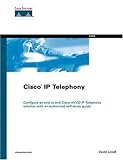Cisco IP Telephony (Cisco Certification & Training)
Cisco IP Telephony (Cisco Certification & Training)

Cisco authorized self-study book for IP Telephony foundation learning
Cisco IP Telephony offers indispensable information on how to
- Configure and implement an end-to-end IP telephony solution using Cisco CallManager and CIPT devices to converge your voice and data networks
- Create, configure, and manage Cisco CallManager clusters to support small user environments as well as larger user environments with up to 10,000 users
- Optimize routing flexibility into your CIPT network design using route plans
- Ensure telephony class of service with partitions and calling search spaces
- Effect moves, adds, and changes on a large number of users and devices quickly and efficiently
- Perform proper installation, upgrade, and backup of Cisco CallManager clusters
- Monitor and perform troubleshooting tasks for a CIPT solution
Cisco IP Telephony is a Cisco authorized self-paced learning tool. This book provides networking professionals with the fundamentals to implement a Cisco AVVID IP Telephony solution that can be run over a data network, therefore reducing costs associated with running separate data and telephone networks. Cisco IP Telephony focuses on using Cisco CallManager and other IP telephony components connected in LANs and WANs. This book provides you with a foundation for working with Cisco IP Telephony products, specifically Cisco CallManager. If your task is to install, configure, support, and maintain a CIPT network, this is the book for you.
Part I of Cisco IP Telephony introduces IP telephony components in the Cisco AVVID environment. Part II covers basic CIPT installation, configuration, and administration tasks, including building CallManager clusters; configuring route plans, route groups, route lists, route patterns, partitions, and calling search spaces; configuring and managing shared media resources such as transcoders, conference bridges, and music on hold; configuring and managing Cisco IP Phone features and users; configuring IP telephony component hardware and software; automating database moves, adds, and changes using the Bulk Administration Tool (BAT); and installing, upgrading, and creating backups for Cisco CallManager components. Part III deals with advanced CIPT configuration tasks for call preservation and shared media resources; covers distributed and centralized call processing model design in WAN environments; explains how to deploy Survivable Remote Site Telephony (SRST) to provide local call processing redundancy at remote branch sites; and provides tips, guidelines, and rules for deploying a Cisco IP Telephony solution, culled from seasoned practitioners in the field. Part IV focuses on three of the primary Cisco applications designed for integration in a Cisco CallManager environment-Cisco WebAttendant, Cisco IP SoftPhone, and Cisco Unity(tm). All this detailed information makes Cisco IP Telephony an ideal resource for the configuration and management of a Cisco IP Telephony solution.
Cisco IP Telephony is part of a recommended learning path from Cisco Systems that can include simulation and hands-on training from authorized Cisco Learning Partners and self-study products from Cisco Press.Books in this series provide officially developed training solutions to help networking professionals understand technology implementations and prepare for the Cisco Career Certifications examinations.Digitizing voice signals and transmitting them over an IP network offers tremendous advantages, particularly in closely controlled environments like offices and contact centers. Cisco Systems sees voice over IP (VoIP) as a strategic opportunity, and therefore has innovated considerably in the area. Cisco IP Telephony explains how to design and build voice infrastructures in which call-control services are provided by one or more CallManager units. In addition to his coverage of CallManager, David Lovell pays attention to the 7900 series of IP phones and to Cisco's line of voice gateway products, as well as products that improve the reliability of IP phones. Consider this book a comprehensive guide to configuring CallManager and designing dial plans under it. Look elsewhere for detailed discussions of how to configure routers for VoIP quality of service (QoS) and bandwidth requirements. Consider Cisco CallManager Fundamentals for more detailed information on CallManager call flows, particularly as they relate to activity across multiple geographic sites, and practical matters like fail-safe routing of emergency calls.
David Lovell, a Cisco instructor, first shows how to configure CallManager clusters (he explains CallManager concepts like partitions and route groups, and uses step-by-step procedures to show how to set them up). Coverage includes such new features as music on hold (MOH) servers and the Bulk Administration Tool (BAT). Later chapters use the same instructional style to explain Survivable Remote Site Telephony (SRST) and a handful of applications: WebAttendant, IP SoftPhone, and Unity messaging. Coverage of the applications is pretty scanty (and there's nothing on the IP Contact Center--IPCC--application), but it's enough to get readers oriented, and the deep CallManager coverage more than compensates. --David Wall
Topics covered: The suite of clients, infrastructure devices, call-control systems, and, to a limited extent, applications that make up Cisco Systems' voice over IP offerings. Emphasis falls on CallManager 3.1, particularly on configuring it to talk to telephony devices and to recognize users. The Bulk Administration Tool (BAT), CallManager numbering and route plans, redundancy strategies (including those that use Survivable Remote Site Telephony--SRST), and design best practices all get attention.

List Price: $ 60.00
Price: $ 6.61
RelatedCertification Products
No comments:
Post a Comment